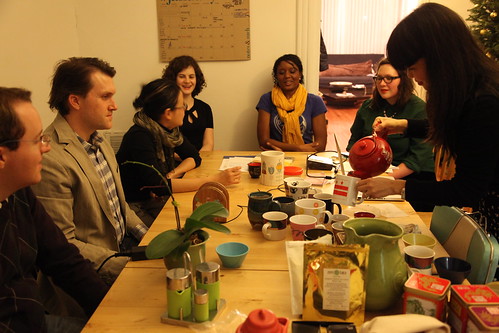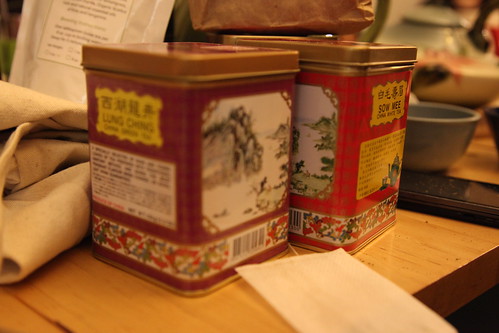Class Report
Tea: An Intercultural Introduction

About a year ago, I sampled a deliciously delicate vanilla apricot tea. It was so enticing that I immediately purchased a box to take home. In the comfort of my own kitchen, I excitedly brewed a cup, anticipating the heavenly scent to yield a refreshing beverage.Much to my displeasure, the bitter result was undrinkable. I thought I must have chosen a bad box, and sadly pushed it to the back of my cupboard. A couple weeks ago, I discovered that the disappointment was my fault. Turns out tea isn’t as easy as simple as Lipton makes it appear to be.
At a recent Knowledge Commons DC class, Tea: An Intercultural Introduction, I learned a assortment of interesting trivia and useful tips about the second most popular drink in the world. Instructors Erika and Valerie introduced the class to a variety of loose leaf teas ranging from Chinese Dragon to South African rooibos. The major varieties of tea – black, oolong, green and white – all come from the same Camellia sinensisplant, but achieve different tastes depending on how long they are processed. The variety also determines how long, and at what water temperature, to brew the tea. Because white tea is the least processed, and therefore most delicate (and least caffeinated), it requires less brewing time and cooler water. THIS is what I needed to know a year ago.
Valerie explained the differences as she demonstrated parts of a traditional Japanese tea ritual. Erika told us about the invention of the tea bag and described how tea was introduced to the United States, where 80% of the beverage is drunk iced.While riding the slightest of caffeine buzzes after sampling six types, our group of veteran connoisseurs and newbie tea drinkers discussed the merits of loose leaf versus bagged, herbal infusions and remedy teas, cup size and type of pots – even whether leaves could, or should, be brewed a second time.
Armed with my new basic knowledge of tea, I was ready to pay a visit to one of the tea shops Erika recommended. The Spice and Tea Exchange in Georgetown, Zen Tara Teas in Bethesda , and Capital Teas in DC.
When I returned home, I eagerly sifted through the cereal and crackers in my cupboard to retrieve the box of tea I had hidden months ago. As I carefully watched the temperature of my simmering water and the clock while the bag steeped, I hoped I remembered my lesson correctly. The result was not quite as I remembered that initial taste, but certainly a potable preference to my first attempt. With more than 1,500 varieties of tea to sample, I have plenty of options for future practice.

